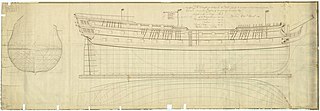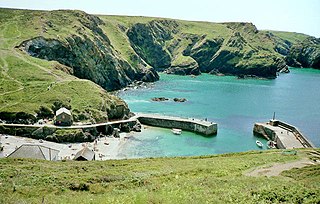
HMS Colossus was a 74-gun third-rate ship of the line of the Royal Navy. She was launched at Gravesend on 4 April 1787 and lost on 10 December 1798. During her years of service she participated in the Battle of Groix, the Battle of Cape St Vincent, and the Battle of the Nile. While carrying wounded from the latter, she was wrecked at the Isles of Scilly. The wreck is a Protected Wreck managed by Historic England.

Gunwalloe is a coastal civil parish in Cornwall, England, United Kingdom. It is situated on the Lizard Peninsula three miles (4.8 km) south of Helston and partly contains The Loe, the largest natural freshwater lake in Cornwall. The parish population including Berepper at the 2011 census was 219. The hamlets in the parish are Chyanvounder, Berepper and Chyvarloe. To the east are the Halzephron cliffs and further east the parish church.

Mullion Cove, or Porth Mellin, is a small community on the West Coast of the Lizard Peninsula in Cornwall, England, and on the eastern side of Mount's Bay. The Cove forms part of the parish of Mullion, and is accessible by road from Mullion village, 1 mile (1.6 km) to the northeast, and also via the South West coast path. It lies within an Area of Outstanding Natural Beauty.
St Anthony or Santo António was a Portuguese carrack that foundered in Gunwalloe Bay, Cornwall, in 1527 en route from Lisbon to Antwerp. She had a mixed cargo including copper and silver ingots. The wreck was recorded historically, because the salvage of the cargo was the subject of an international dispute that led to a Court of Star Chamber, but the location of the wreck was unknown until 1981. The wreck is designated under the Protection of Wrecks Act and is managed by Historic England.
The Wheel Wreck is the remains of a shipwreck lying in Crow sound off Little Ganinick in the Isles of Scilly. The wreck site consists of a discrete mound of cargo that appears to consist of numerous sizes of different iron wheels, cogs, clack valves, tubes and boiler pipes. Lead scupper pipes and other small artefact material show the ship was once present, however, not much remains of this vessel today. A Trotmann style anchor lies some 60m from the site, and this along with the cargo, date the site as sometime just after 1835. It has been published that this may be the wreck of the Padstow, however, being lost in 1804 this can not be so as neither boiler tubes or Trotmann anchors were invented back then. The wreck was discovered by local diver Todd Stevens in 2005 and investigated by the archaeological contractor for the Protection of Wrecks Act 1973 in 2006. It still remains unidentified. However it is most likely to be a ship called the 'Plenty' which is recorded locally as having sank- "within 1 mile of the principal island" -in 1840.

Coronation was a 90-gun second-rate ship of the line of the English Royal Navy, built at Portsmouth Dockyard as part of the '30 great ships programme' of 1677, and launched in 1685. She was lost in a storm off Rame Head, Cornwall on 3 September 1691 and is designated under the Protection of Wrecks Act 1973. The wreck is a Protected Wreck managed by Historic England.

Asparagus Island is a small tidal island on the eastern side of Mount's Bay, within the parish of Mullion, Cornwall, United Kingdom. It lies within Kynance Cove, a popular tourist site on the western side of The Lizard peninsula and is named after the rare wild asparagus (Asparagus prostratus) found there.
HMS Schiedam was a Dutch East India fluyt. Captured twice, once by pirates, the ship wrecked off Gunwalloe Cove in 1684. The wreck is a Protected Wreck managed by Historic England.
The Santo Christo de Castello was a mid‐17th century Genoese merchant ship sailing from Amsterdam that was wrecked on its maiden near Mullion Cove, Cornwall, England in 1667. In the late 17th and 18th centuries various efforts were made to recover the silver it was said to have carried. It was then forgotten, but was rediscovered in 1969, and interesting artifacts have been recovered.
The Bartholomew Ledges Wreck is a wreck found in the late 1970s at St Marys Sound, Isles of Scilly is believed to be that of a mid-sixteenth to early seventeenth century armed cargo vessel. The site was designated under the Protection of Wrecks Act on 23 September 1980. The wreck is a Protected Wreck managed by Historic England.
The Chesil Beach cannon consists of the remains of an unknown wreck were found on Chesil Beach, Dorset, England, in 2010. The site was designated on 18 July 2017. The wreck is a Protected Wreck managed by Historic England.
The Tearing Ledge Wreck consists of the remains of a ship, possibly one of the ships belonging to Admiral Cloudisley Shovell's fleet of 21 vessels returning from the Siege of Toulon via Gibraltar, that were found in 1969 on Tearing Ledge, Western Rocks, Isles of Scilly. The site was designated under the Protection of Wrecks Act on 12 February 1975. The wreck is a Protected Wreck managed by the National Heritage List for England.
The remains of a seventeenth century cargo vessel were identified in Gunwalloe fishing cove, Cornwall in 1998. The site was designated under the Protection of Wrecks Act on 23 May 1999. The wreck is a Protected Wreck managed by Historic England.





